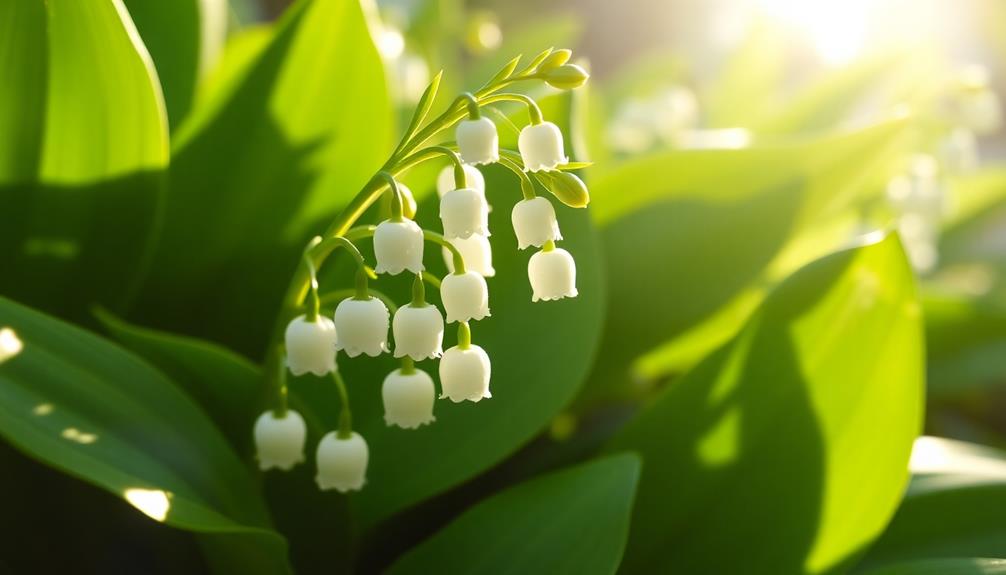Oakmoss has a wonderfully rich, earthy scent that makes you feel like you're walking in a beautiful forest after the rain. Its aroma is a blend of woodsy notes, with a touch of sweetness and a hint of smokiness. As it settles, you might notice a drier, resin-like quality that adds depth. This unique fragrance brings back memories of nature, giving you a calm and cozy feeling. It's often used in perfumes to enhance and prolong the scent. If you're curious about how it's used in different scents or its emotional effects, there's more to explore!
Key Takeaways
- Oakmoss has an earthy, woodsy aroma reminiscent of damp forest floors, evoking a natural and calming atmosphere.
- The scent is musky and slightly sweet, with hints of smokiness that evolve over time.
- It transitions from a damp quality to a drier, more resinous woody essence, enhancing depth in fragrances.
- Oakmoss blends well with other notes, adding richness and complexity, particularly in chypre compositions.
- Its aroma is associated with nostalgia and emotional grounding, often evoking feelings of calmness and intimacy.
Introduction

When exploring the enchanting world of fragrances, the scent of oakmoss stands out for its captivating complexity. This earthy scent isn't just any smell—it's like stepping into a damp forest floor after rain. You can almost feel the rich, musky aroma wrapping around you, inviting you to take a deeper breath.
Oakmoss is often used as a base note in many perfumes, which helps to anchor the fragrance and make it last longer. You might find that oakmoss absolute adds a wonderful layer to scents, mixing with other ingredients to create something magical. Its mossy scents bring a hint of sweetness and a touch of smokiness, making each whiff an adventure.
As you wear fragrances featuring oakmoss, you'll notice how the smell evolves, starting with fresh, damp leaves and transitioning to a drier, woodsy scent.
In chypre scents, oakmoss plays a vital role, enhancing the overall experience. It brings depth and character, making every fragrance more special.
Description of the Smell

The allure of oakmoss lies in its earthy, woodsy aroma that captures the essence of a damp forest floor. When you take a whiff, you might notice a scent that's both musky and slightly sweet, with hints of smokiness dancing in the air.
This unique fragrance evolves from a damp, sodden quality to a drier, woody essence, reminding you of aged wood and fallen leaves underfoot.
Oakmoss offers a complex olfactory experience that can evoke memories of nature. Imagine walking through a soft forest carpet, feeling the velvety texture beneath your feet.
When you apply oakmoss to your skin, it releases a warm, inviting aroma that blends beautifully with other fragrances, making them even richer.
It's often used as a base note in perfumery, which means it helps create depth and richness in a scent.
When combined with citrus and floral notes, oakmoss enhances their overall complexity, making each fragrance feel more complete.
Source and Composition

Oakmoss comes from lichen, specifically Evernia prunastri, which thrives on oak trees. This unique lichen is known for its earthy smell and woody aroma that many people love. The aroma of oakmoss is complex and delightful, thanks to its chemical composition. It contains organic compounds like atranorin, chloroatranorin, and evernic acid. These elements work together to create that rich, warm scent.
You might be surprised to learn that there are different types of oakmoss. For instance, Evernia furfuracea offers a lighter, floral aroma, while Evernia prunastri delivers those robust earthy notes.
When it comes to the extraction process, it's quite interesting! First, the lichen is gathered, then cleaned and dried. After that, solvents like ethanol are used to produce oakmoss absolute through filtration and distillation.
The environment where oakmoss grows can also influence its scent. Factors like moisture levels can change the intensity and character of its aroma.
Typical Scenarios or Environments

Imagine stepping into a lush forest after a rain shower; the air is thick with the earthy, woody aroma that oakmoss embodies. You can almost smell the dampness of the forest floor, filled with wet leaves and bark. This fragrance creates a cozy environment, inviting you to explore deeper into the woods.
In typical scenarios, like walking through a humid woodland, you'll find that oakmoss adds a grounding scent to the air. It's often found in traditional chypre fragrances, where it brings a deep, shadowy effect. This reminds you of aged oak trees in a peaceful glade.
As you wander, the scents of moss-covered rocks and decaying logs mix beautifully, creating a rich tapestry of aromas.
Oakmoss works well with other earthy notes, enhancing the overall fragrance experience. It acts as a fixative in perfumery, helping to prolong the scent of other notes. This means that the olfactory environment feels layered and complex, much like the vibrant ecosystems you encounter in nature.
Emotional or Cultural Associations

Richly layered and evocative, the aroma of oakmoss often brings forth feelings of calmness and nostalgia. When you breathe in its earthy scent, you might picture damp forest floors or expansive natural landscapes. This connection can make you feel relaxed and at peace.
Many cultures have recognized oakmoss for its grounding properties, helping you achieve emotional balance during stressful times. In relationships, emotional coldness can sometimes stem from a lack of grounding and connection, making the soothing scent of oakmoss particularly relevant in fostering intimacy and communication during challenging times.
Professional help can also guide couples through these emotional distances.
In the world of perfumery, oakmoss smells luxurious and sophisticated. It's a key ingredient in classic chypre compositions, adding depth and richness to fragrances you might adore. The scent can transport you to a world of elegance, making every spritz feel special.
Oakmoss has a history too! Native Americans valued it for its antiseptic properties, using it to support respiratory health.
While it's less common in cooking today, it once enhanced flavors in dishes, especially game meats, during the 18th and 19th centuries.
Health or Safety Considerations

When considering the health and safety aspects of using oakmoss in fragrances, it's essential to be aware of potential allergens. Oakmoss contains allergens like chloroatranol and atranol, which can lead to skin sensitization and irritation for some people.
Because of this, there are regulatory restrictions on how much oakmoss can be used. For example, the European Union limits its concentration in skin-applied fragrances to just 0.1%.
The International Fragrance Association has even blacklisted oakmoss due to its irritant potential. This has made it harder for perfumers to include it in new fragrance creations.
While many have tried to find alternative ingredients that mimic its unique scent, none have quite succeeded.
If you're someone with sensitive skin or known allergies, it's a good idea to perform patch tests before using products with oakmoss. This simple step can help you avoid any unwanted reactions.
Final Thoughts

In exploring the unique scent of oakmoss, you uncover a complex fragrance that resonates with nature. This earthy and woodsy aroma takes you on a journey through a damp forest floor, where hints of musk and sweetness linger in the air.
As you experience oakmoss, its scent evolves from a wet, leafy smell to a drier, resinous woody note. It's like each whiff tells a story! The journey is reminiscent of a walk through a damp forest that gradually dries under the sun, revealing deeper nuances with every step. Just as you begin to appreciate the complexity of oakmoss, another question floats into your mind—*what does neroli smell like*? Its fresh, floral, and slightly citrusy scent would be a perfect contrast to the earthy richness unfolding before you.
When you wear oakmoss in your favorite perfume, you'll notice how warm and inviting it feels. This fragrance blends beautifully with other notes, creating a delightful harmony that lasts longer on your skin.
Oakmoss isn't just a scent; it evokes feelings of calmness and nostalgia, making it a cherished ingredient in aromatherapy and perfumery.
Each time you encounter oakmoss, it may smell a little different depending on what it's mixed with. This adds to its unique character in various fragrance compositions.
Frequently Asked Questions
What Does Oakmoss Perfume Smell Like?
When you experience oakmoss perfume, you'll notice its earthy, woodsy aroma enveloping you. The scent's warm, musky notes blend with subtle sweetness and smokiness, creating a rich, inviting fragrance that evolves beautifully on your skin.
Why Is Oakmoss Prohibited in Perfume?
Oakmoss is prohibited in perfume due to its potential skin irritations and allergic reactions. Regulations limit its use in fragrances to protect consumers, pushing perfumers to find alternatives that maintain scent depth without compromising safety.
What Scents Go Well With Oakmoss?
When you're blending fragrances, consider pairing oakmoss with citrus notes like bergamot, warm woods like vetiver, or floral hints such as jasmine. Spicy elements and gourmand notes also enhance its richness and complexity beautifully.
Does Oakmoss Smell Like Patchouli?
You might notice that oakmoss and patchouli share earthy tones, but they're distinct. Oakmoss has a damp, musty scent, while patchouli offers a sweeter, spicier aroma, creating different experiences in perfumes and blends.









